活塞式燃气发电机工作原理
燃气发电机组原理

燃气发电机组原理燃气发电机组是一种利用燃料燃烧产生热能,再将其转化为电能的装置。
它不仅在商业和工业领域得到广泛应用,也成为了家庭备用电源的重要选择。
燃气发电机组的工作原理相对简单,但其所发挥的作用却十分重要。
燃气发电机组的关键组成部分是燃烧室和发动机。
在燃烧室中,燃料与空气混合并点燃,产生高温高压的气体。
这些气体驱动发动机的活塞运动,通过连杆和曲轴的转动,将机械能转化为电能。
燃烧室中的点火过程是燃气发电机组的核心。
为了确保燃烧室内的燃料和空气混合均匀,燃气发电机组通常采用预混合式燃烧。
燃料经过供气系统进入燃烧室,与空气在喷嘴处混合,形成可燃气体。
同时,发动机控制系统监测燃气发电机组的运行状态,根据需要调整燃料和空气的比例,以保持燃烧的稳定性和效率。
发动机的工作原理类似于汽车发动机,但燃气发电机组更加高效。
它采用了内燃式往复式发动机,通过活塞在气缸内的上下运动,将燃烧室中的高温高压气体转化为机械能。
这种转化是通过连杆和曲轴的连动来实现的,连杆将活塞的线性运动转化为曲轴的旋转运动,进而驱动发电机转子旋转,产生电能。
燃气发电机组的优势在于其高效率和环保性能。
相比传统的燃煤发电厂,燃气发电机组在燃烧过程中产生的废气排放量更少,对环境的影响更小。
此外,燃气发电机组的启动时间较短,响应速度较快,可在电力需求急剧增加时提供紧急供电。
燃气发电机组是一种高效、环保的电力生产装置。
其工作原理简单明了,通过燃烧室和发动机的协同工作,将燃料的化学能转化为机械能,再转化为电能。
燃气发电机组在商业、工业和家庭领域的广泛应用,为我们提供了稳定可靠的电力供应。
燃机发电原理
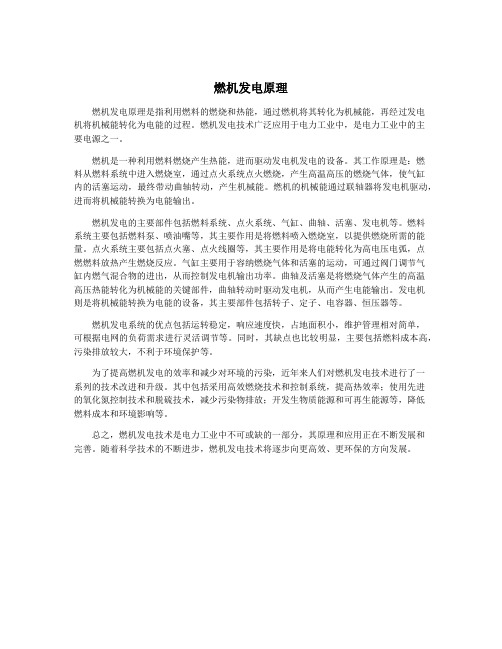
燃机发电原理燃机发电原理是指利用燃料的燃烧和热能,通过燃机将其转化为机械能,再经过发电机将机械能转化为电能的过程。
燃机发电技术广泛应用于电力工业中,是电力工业中的主要电源之一。
燃机是一种利用燃料燃烧产生热能,进而驱动发电机发电的设备。
其工作原理是:燃料从燃料系统中进入燃烧室,通过点火系统点火燃烧,产生高温高压的燃烧气体,使气缸内的活塞运动,最终带动曲轴转动,产生机械能。
燃机的机械能通过联轴器将发电机驱动,进而将机械能转换为电能输出。
燃机发电的主要部件包括燃料系统、点火系统、气缸、曲轴、活塞、发电机等。
燃料系统主要包括燃料泵、喷油嘴等,其主要作用是将燃料喷入燃烧室,以提供燃烧所需的能量。
点火系统主要包括点火塞、点火线圈等,其主要作用是将电能转化为高电压电弧,点燃燃料放热产生燃烧反应。
气缸主要用于容纳燃烧气体和活塞的运动,可通过阀门调节气缸内燃气混合物的进出,从而控制发电机输出功率。
曲轴及活塞是将燃烧气体产生的高温高压热能转化为机械能的关键部件,曲轴转动时驱动发电机,从而产生电能输出。
发电机则是将机械能转换为电能的设备,其主要部件包括转子、定子、电容器、恒压器等。
燃机发电系统的优点包括运转稳定,响应速度快,占地面积小,维护管理相对简单,可根据电网的负荷需求进行灵活调节等。
同时,其缺点也比较明显,主要包括燃料成本高,污染排放较大,不利于环境保护等。
为了提高燃机发电的效率和减少对环境的污染,近年来人们对燃机发电技术进行了一系列的技术改进和升级。
其中包括采用高效燃烧技术和控制系统,提高热效率;使用先进的氧化氮控制技术和脱硫技术,减少污染物排放;开发生物质能源和可再生能源等,降低燃料成本和环境影响等。
总之,燃机发电技术是电力工业中不可或缺的一部分,其原理和应用正在不断发展和完善。
随着科学技术的不断进步,燃机发电技术将逐步向更高效、更环保的方向发展。
燃机发电原理
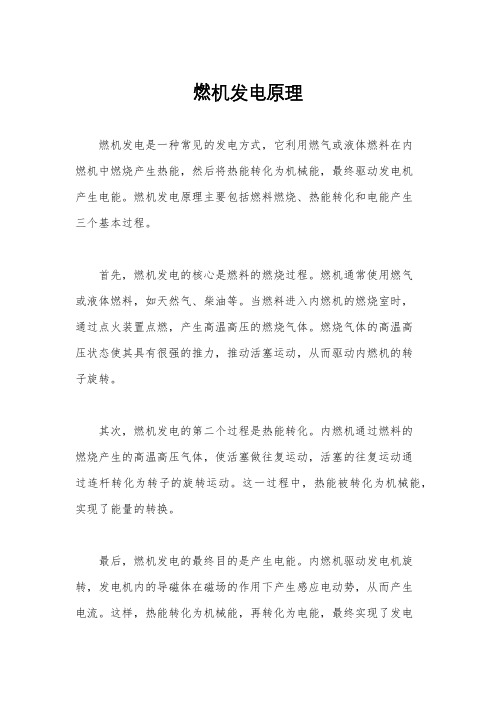
燃机发电原理燃机发电是一种常见的发电方式,它利用燃气或液体燃料在内燃机中燃烧产生热能,然后将热能转化为机械能,最终驱动发电机产生电能。
燃机发电原理主要包括燃料燃烧、热能转化和电能产生三个基本过程。
首先,燃机发电的核心是燃料的燃烧过程。
燃机通常使用燃气或液体燃料,如天然气、柴油等。
当燃料进入内燃机的燃烧室时,通过点火装置点燃,产生高温高压的燃烧气体。
燃烧气体的高温高压状态使其具有很强的推力,推动活塞运动,从而驱动内燃机的转子旋转。
其次,燃机发电的第二个过程是热能转化。
内燃机通过燃料的燃烧产生的高温高压气体,使活塞做往复运动,活塞的往复运动通过连杆转化为转子的旋转运动。
这一过程中,热能被转化为机械能,实现了能量的转换。
最后,燃机发电的最终目的是产生电能。
内燃机驱动发电机旋转,发电机内的导磁体在磁场的作用下产生感应电动势,从而产生电流。
这样,热能转化为机械能,再转化为电能,最终实现了发电的目的。
总的来说,燃机发电原理是通过燃料的燃烧产生高温高压气体,驱动内燃机的运转,将热能转化为机械能,最终驱动发电机产生电能。
这种发电方式具有结构简单、运行稳定、效率高等优点,在现代工业和生活中得到了广泛应用。
燃机发电的原理虽然简单,但是在实际应用中需要考虑燃料的选择、燃烧效率、内燃机的设计和发电机的性能等多个方面的因素。
只有综合考虑这些因素,才能实现燃机发电的高效稳定运行。
随着科技的不断发展,燃机发电技术也在不断改进和完善,为人类提供了可靠的电力保障。
总之,燃机发电原理是一种重要的发电方式,其核心是燃料燃烧产生热能,再将热能转化为机械能,最终产生电能。
通过对燃机发电原理的深入了解,可以更好地掌握燃机发电技术,为其在实际应用中的运行和维护提供有力支持。
燃气发电机的工作原理

燃气发电机的工作原理燃气发电机是一种利用燃气燃烧产生热能,并将其转化为电能的发电设备。
它是一种高效、环保的发电方式,被广泛应用于许多领域,如工业生产、商业建筑和家庭用电等。
燃气发电机的工作原理可简单描述为下面的几个步骤:燃气进气、燃烧、膨胀和发电。
燃气通过管道输送至发电机内部。
发电机通常配备有燃气管道和调节阀,以控制燃气进气量。
这样可以根据需求来调整燃气的供应量,以保证发电机的正常运行。
接下来,燃气进入发动机内部的燃烧室。
在燃烧室中,燃气与空气混合并点燃。
燃气通常是天然气或液化石油气等,它们都是可燃的燃料。
通过点燃燃气,可以释放出大量的热能。
燃烧释放的热能使得燃气发生膨胀,产生高温高压的气体。
这些气体推动活塞运动,从而带动曲轴转动。
发电机的曲轴与发电机组件相连,当曲轴转动时,发电机组件也会跟着转动。
发电机组件中的转子和定子之间的磁场相互作用,产生电磁感应。
这个过程通过法拉第电磁感应定律来解释,即当磁场变化时,会在导体中产生感应电流。
通过转子和定子之间的电磁感应,电能就会被转化并输出。
燃气发电机的工作原理可以看作是将热能转化为机械能,再将机械能转化为电能的过程。
它的高效率和环保性主要得益于燃气燃烧过程的特性。
相比传统的燃煤发电,燃气发电机在燃烧过程中产生的废气更少,污染更少,对环境的影响更小。
燃气发电机还具有灵活性和可靠性的优势。
由于燃气发电机可以根据需求进行启停和调节,因此在应对能源需求波动和应急情况时更加灵活。
同时,燃气发电机的结构相对简单,运行稳定可靠,能够长时间运行而不损坏。
燃气发电机利用燃气的燃烧过程将热能转化为电能。
其工作原理是通过燃气进气、燃烧、膨胀和发电等过程实现的。
燃气发电机具有高效、环保、灵活和可靠的特点,被广泛应用于各个领域。
随着对清洁能源需求的增加,燃气发电机的应用前景将更加广阔。
天然气发电机组
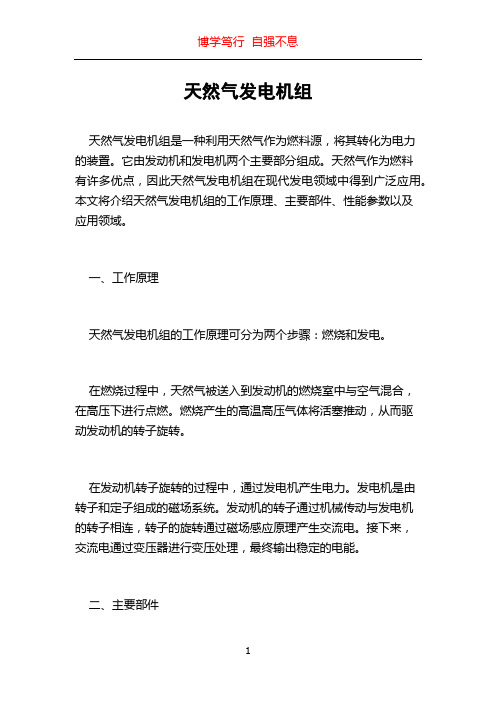
天然气发电机组天然气发电机组是一种利用天然气作为燃料源,将其转化为电力的装置。
它由发动机和发电机两个主要部分组成。
天然气作为燃料有许多优点,因此天然气发电机组在现代发电领域中得到广泛应用。
本文将介绍天然气发电机组的工作原理、主要部件、性能参数以及应用领域。
一、工作原理天然气发电机组的工作原理可分为两个步骤:燃烧和发电。
在燃烧过程中,天然气被送入到发动机的燃烧室中与空气混合,在高压下进行点燃。
燃烧产生的高温高压气体将活塞推动,从而驱动发动机的转子旋转。
在发动机转子旋转的过程中,通过发电机产生电力。
发电机是由转子和定子组成的磁场系统。
发动机的转子通过机械传动与发电机的转子相连,转子的旋转通过磁场感应原理产生交流电。
接下来,交流电通过变压器进行变压处理,最终输出稳定的电能。
二、主要部件天然气发电机组主要由以下部件组成:1. 发动机:发动机是天然气发电机组的核心部件,它负责将燃气能量转化为机械能。
发动机根据其工作循环类型的不同可分为两冲程发动机和四冲程发动机。
2. 发电机:发电机是将机械能转化为电能的部件。
它由转子和定子组成的磁场系统产生电能。
3. 控制系统:控制系统负责监测和控制发动机和发电机的运行状态,确保其正常工作。
4. 冷却系统:天然气发动机运行时会产生大量的热量,冷却系统负责降低发动机的温度,保证其正常运行。
5. 燃气系统:燃气系统负责将天然气输送到发动机燃烧室中,确保燃烧的顺利进行。
三、性能参数天然气发电机组的性能参数主要包括额定功率、效率、噪音和排放等指标。
1. 额定功率:天然气发电机组的额定功率是指在额定工况下,发电机组能够稳定运行并输出的功率。
2. 效率:天然气发电机组的效率是指其将输入热量转化为电能的比例。
一般情况下,高效率的发电机组能够更有效地利用燃料。
3. 噪音:天然气发电机组产生的噪音主要来自发动机的运行和风扇的转动。
低噪音的发电机组能够减少对环境和周围居民的干扰。
4. 排放:天然气发电机组在燃烧过程中会产生废气排放,包括一氧化碳、氮氧化物等。
发电机的结构和工作原理
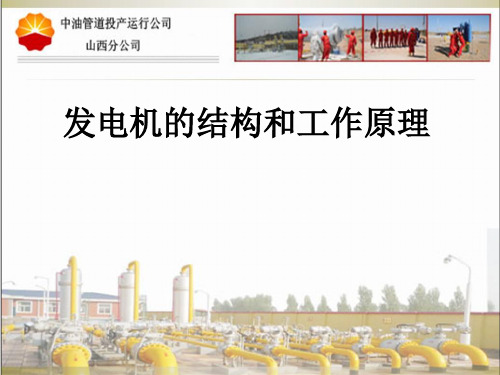
一、燃气发电机的结构和工作原理
12V190系列燃气发电机组由12V190系列发动机、1FC6发 电机两部分组成,并配备控制屏、TEM电子管理系统等
发动机 发电机
控制柜
底盘
发电机组的定义 1、发动机的定义: 发动机是一种将燃料的热能转换为机械能输出的动力装置。 2、发电机的定义: 发电机是一种将机械能转换为电能输出的动力装置。
•
配气机构工作示意图
发动机的配气机构能够控制 发动机的进气过程和排气过程。 其工作过程为: 曲轴通过齿轮的传动,带动 凸轮轴运转。当凸轮轴上的凸轮 凸尖和滚轮摇臂接触时,滚轮摇 臂带动挺杆上移,将力传递给气 门摇臂,气门摇臂下压摇臂横桥, 摇臂横桥克服气门弹簧弹力(气 门弹簧压缩)迫使两个进气门 (或排气门)同时打开;当凸轮 轴上的凸轮凸尖脱离和滚轮摇臂 接触时,气门在弹簧的弹力作用 下恢复到关闭状态。
大循环 机油泵2把机油压送到机油泵支架出口2从机体右侧经单向减压 阀,流过机油冷却器、机油滤清器,然后经机体油道进入主油道内。 进入主油道的机油通过机体内部油道分别送到曲轴主轴承、凸轮轴 轴承、摇臂轴轴承和气缸盖上的气门机构。
•
4、离心滤清器 工作原理: 机油经管接4和转子中 间孔道进入密闭的转子组 内腔。 在一定的机油压力作 用下,充满转子组内腔的 机油经集油管从底部喷嘴 上的小孔高速喷出。 • 由于喷射的反作用力 矩作用,使转子组带动内 部机油高速旋转,在离心 力的作用下,机油中的杂 质被甩向转子体内部,而 清洁的机油则不断地经喷 孔喷出,流回油底壳。
2、配气机构及进排气系统
1、配气机构的作用: 驱动气缸盖上气门摇臂,控制进、排气门的开启与关闭,保证 新鲜空气及时充入气缸,并将燃烧后的废气及时排出。 2、配气机构的构造:
燃气发电机工作原理
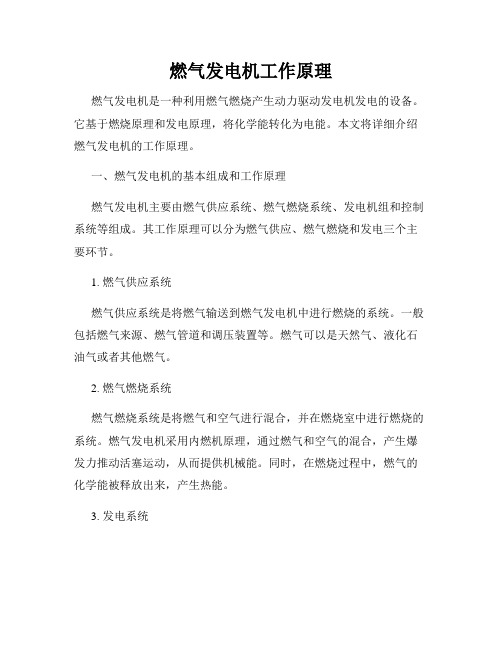
燃气发电机工作原理燃气发电机是一种利用燃气燃烧产生动力驱动发电机发电的设备。
它基于燃烧原理和发电原理,将化学能转化为电能。
本文将详细介绍燃气发电机的工作原理。
一、燃气发电机的基本组成和工作原理燃气发电机主要由燃气供应系统、燃气燃烧系统、发电机组和控制系统等组成。
其工作原理可以分为燃气供应、燃气燃烧和发电三个主要环节。
1. 燃气供应系统燃气供应系统是将燃气输送到燃气发电机中进行燃烧的系统。
一般包括燃气来源、燃气管道和调压装置等。
燃气可以是天然气、液化石油气或者其他燃气。
2. 燃气燃烧系统燃气燃烧系统是将燃气和空气进行混合,并在燃烧室中进行燃烧的系统。
燃气发电机采用内燃机原理,通过燃气和空气的混合,产生爆发力推动活塞运动,从而提供机械能。
同时,在燃烧过程中,燃气的化学能被释放出来,产生热能。
3. 发电系统发电系统由发电机组成,将机械能转化为电能。
燃气发电机可以采用直流发电或交流发电。
发电机通过转子和定子之间的磁场相互作用,将机械能转化为电能,输出给外部负载。
4. 控制系统控制系统是控制燃气发电机的关键部分,它通过监测和调节燃气供应、燃烧和发电等参数,确保燃气发电机的正常运行。
控制系统通常包括传感器、电子控制器和监控仪表等设备。
二、燃气发电机的工作流程燃气发电机的工作流程可以分为四个步骤:进气、压缩、燃烧和排气。
1. 进气燃气发电机启动后,燃气供应系统将燃气输送到燃气发电机中。
燃气经过滤清除杂质后,进入燃气发动机的进气道。
2. 压缩进入燃气发动机的燃气在进气道内被压缩。
压缩过程通过活塞的上下运动实现。
当活塞向上运动时,气体被压缩并注入燃烧室。
3. 燃烧经过压缩的燃气在燃烧室内与空气混合并被点燃。
燃料的燃烧会产生高温和高压气体,并推动活塞向下运动。
同时,燃烧过程中释放的热能也被吸收,用于发电。
4. 排气燃气发电机工作完成后,排气系统将燃烧后产生的废气排出。
废气在排气阀的作用下,通过排气管道排出燃气发电机。
详解燃气发电机组的优点与工作原理

详解燃气发电机组的优点与工作原理简介:燃气发电机组是一种利用燃气燃烧产生的热能转化为电能的设备。
它以燃气作为燃料,并且具有一系列的优点和特点。
本文将详细介绍燃气发电机组的工作原理和其所具备的优点。
一、工作原理:燃气发电机组是将燃气燃烧产生的高温高压气体推动活塞,通过活塞运动带动发电机转子旋转,最终产生电能的一种发电设备。
它的工作原理主要包括以下几个步骤:1. 燃气供给:燃气发动机需要从外部供应燃气燃料,通常使用天然气、液化石油气等作为燃料。
燃气供应系统将燃气输送至燃气发动机内部。
2. 燃气燃烧:燃气发动机内部的燃烧室将燃气与空气混合,并通过点火装置点燃燃气。
燃烧产生的高温高压气体将推动活塞向下运动。
3. 活塞运动:燃气发动机的活塞将被推动向下运动,这个运动过程转化为机械能,并带动曲轴旋转。
4. 发电机转子旋转:曲轴的旋转带动发电机转子旋转,从而产生电能。
5. 电能输出:最终,燃气发电机组将产生的电能输出到电力系统中,为用户提供电力供应。
二、优点与特点:燃气发电机组具有以下一些优点和特点:1. 高效节能:燃气发电机组的高效节能是其最显著的优点之一。
相对于传统的煤电发电,燃气发电的效果更为高效,能够大幅减少燃料消耗和烟尘排放。
2. 环保清洁:燃气发电机组利用燃气作为燃料,燃烧产生的废气中含有的污染物相对较低,排放更为清洁。
与煤电发电相比,燃气发电不会产生大量的烟尘和二氧化硫等有害气体。
3. 运行稳定:燃气发电机组的运行稳定性较高,转速变化小,震动和噪音较低,使用寿命较长。
4. 快速启动:燃气发电机组的启动速度很快,不需要长时间的预热过程,可以在短时间内迅速投入工作,满足紧急用电需求。
5. 可调电压:燃气发电机组可以根据实际需求进行电压的调节,适应不同的用电设备,提供稳定的电能供应。
6. 运维成本低:相对于其他发电方式,燃气发电机组的运维成本较低。
燃气燃料价格相对较稳定,在长期运行中具有较高的可靠性和经济性。
天然气发电机组工作原理

天然气发电机组工作原理
一、简介
天然气发电机组是一种利用天然气作为燃料,通过内燃机转动发电机发电的设备。
其工作原理主要包括燃气进气、燃烧、排放和发电四个环节。
二、燃气进气
天然气通过管道输送到天然气发电机组中,经过过滤器和减压阀降低压力后进入内燃机的进气系统。
在进入内燃机之前,天然气还需要被混合器混合空气,以确保其能够被充分燃烧。
三、燃烧
经过混合后的天然气和空气进入内燃机中,在高温高压的条件下进行可控爆轰式的燃烧反应。
这个反应会产生大量的高温高压的废气,同时也会带动内部的活塞运动,驱动整个发电机组旋转。
四、排放
在完成能量转换之后,废弃物需要被排出。
在这个过程中,废弃物会通过排放管道排出,并严格按照国家相关标准进行处理和处理。
五、发电
内部活塞运动所带来的机械能会被传递到发电机上,进而转化为电能。
这个过程中,发电机的转子和定子之间通过磁场相互作用产生电流,
最终输出电力。
六、总结
天然气发电机组是一种高效、环保的发电设备。
其工作原理主要包括
燃气进气、燃烧、排放和发电四个环节。
这些环节密切配合,确保了
整个系统的正常运行。
活塞带动曲轴原理-概述说明以及解释

活塞带动曲轴原理-概述说明以及解释1.引言1.1 概述概述部分:活塞及曲轴是内燃机等机械装置中不可或缺的重要组成部分。
活塞作为一个圆柱体,通过气压或液压作用下的往复运动,将化学能、热能等能量转化为机械能,推动曲轴旋转,从而驱动机械装置的运转。
而曲轴则是将活塞往复运动转化为旋转运动的核心部件,它将活塞的上下往复运动转换为连续的旋转运动,并将动力传递给其他机械部件。
本文将详细介绍活塞和曲轴的作用及活塞带动曲轴的原理。
我们将分析活塞在内燃机中的重要作用以及曲轴在传动系统中的重要性,同时探讨活塞是如何通过连杆与曲轴相连接,最终实现活塞带动曲轴的机制。
通过对这些原理的深入了解,我们可以更好地理解内燃机等机械装置的工作原理,并对其中的创新和发展方向有所启发。
在结论部分,我们将总结活塞带动曲轴的重要性,并探讨其在不同领域的应用。
同时,我们还将探讨可能的发展方向,包括高效率和环保的新型曲轴设计、以及使用更先进材料制造活塞和曲轴的可能性,以提高机械装置的性能和可靠性。
通过本文的阅读,读者将能够全面了解活塞带动曲轴的原理,从而对内燃机等机械装置的工作原理和发展有更深入的认识。
同时,本文也将为读者提供一些创新思路和可能的技术方向,以促进相关领域的研究和发展。
1.2文章结构文章结构部分的内容:本文主要围绕着活塞带动曲轴的原理展开讨论。
为了使读者更好地理解活塞带动曲轴的工作原理,文中将分为引言、正文和结论三个部分。
在引言部分,我们首先对整篇文章进行概述,介绍活塞带动曲轴的基本概念和作用。
随后,我们将介绍文章的结构安排,让读者了解本文的整体框架和内容组织方式。
最后,我们明确了本文的目的,即通过对活塞带动曲轴原理的解析,深入探讨其重要性和可能的发展方向。
在正文部分,我们将分别详细介绍活塞和曲轴的作用。
首先,我们将详细阐述活塞在发动机中的角色和功能,包括如何通过活塞的上下运动来改变燃烧室容积,实现燃烧效果的最大化。
接着,我们将着重讲解曲轴的作用,探讨其在发动机中的功能和重要性,包括曲轴的旋转运动如何将活塞的线性运动转化为输出动力。
济柴12V190机组介绍
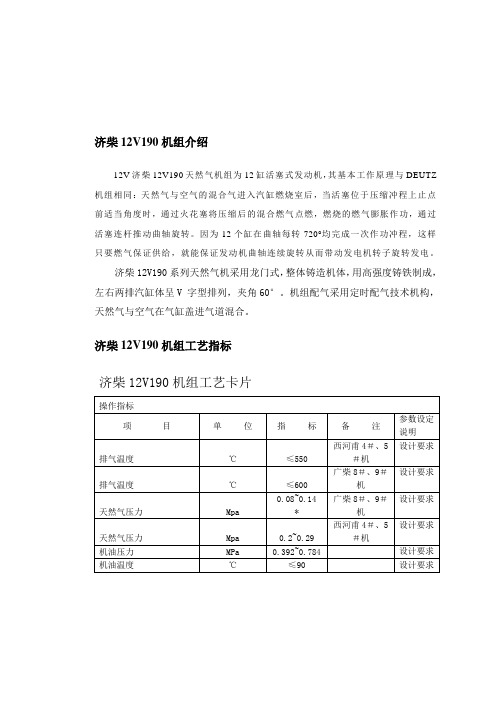
济柴12V190机组介绍12V济柴12V190天然气机组为12缸活塞式发动机,其基本工作原理与DEUTZ 机组相同:天然气与空气的混合气进入汽缸燃烧室后,当活塞位于压缩冲程上止点前适当角度时,通过火花塞将压缩后的混合燃气点燃,燃烧的燃气膨胀作功,通过活塞连杆推动曲轴旋转。
因为12个缸在曲轴每转720°均完成一次作功冲程,这样只要燃气保证供给,就能保证发动机曲轴连续旋转从而带动发电机转子旋转发电。
济柴12V190系列天然气机采用龙门式,整体铸造机体,用高强度铸铁制成,左右两排汽缸体呈V 字型排列,夹角60°。
机组配气采用定时配气技术机构,天然气与空气在气缸盖进气道混合。
济柴12V190机组工艺指标济柴12V190机组工艺卡片济柴12V济柴12V190发电机组发电机电压:●控制范围:发电机电压:380±19V●控制目标:保证发电机电压控制在给定范围。
●相关参数:母线电压、发电机机无功功率、电网频率、励磁电压、励磁电流。
●控制方式:由发电机的励磁系统进行调整,正常情况下发电机根据电压的变化进行自动调整。
也可采用人为控制方式调整发电机电压。
●正常调整:通过操作发电机电压调整开关来增加或降低发电机电压。
发电机频率:●控制范围:发电机频率:50±0.5Hz●控制目标:保证发电机频率控制在给定范围。
●相关参数:母线频率、发动机转速、发电机有功功率。
●控制方式:发电机频率与发动机转速相对应,由系统自动控制。
如果采用有差方式,运行一段时间后发电机频率可能会超出设定范围,需手动调整到正常值。
●正常调整:通过调整发动机转速来调整发电机频率。
发电机有功功率:●控制范围:发电机有功功率不超过机组的实际出力(它随大气温度、运行方式等因素变化),发电机不超过额定功率529KW。
●控制目标:保证发电机和发动机都不出现过负荷情况,且符合运行要求。
●相关参数:电网总负荷、发动机转速、发电机频率、各缸温度。
燃气发电机原理

燃气发电机原理
燃气发电机的工作原理基本上是通过燃烧燃气来带动涡轮机或活塞,进而驱动发电机发电。
整个系统分为燃气供应系统、压气系统、燃烧
系统、涡轮机系统、发电机系统以及控制监测系统组成。
首先,燃气发电机的燃气供应系统是通过一个专门的管道将天然气等
燃气输送到燃气发电机,然后经过一个储气罐和一个压缩机将燃气压
缩至所需的压力,并将燃气传送到燃烧室进行燃烧。
在燃气进入燃烧
室前,需要使用空气将其混合,再由点火器点燃。
接着,燃气发电机的燃烧系统会将混合燃气进行燃烧并产生高温气体,高温气体将会冲向涡轮机或活塞以带动其旋转或移动。
而涡轮机或活
塞则是燃气发电机中另一个非常关键的部分,其作用是将热能转换成
动能,进而驱动发电机转动发电。
涡轮机的旋转速度快而效率高,对
燃气质量、温度、压力等都有严格的要求,而活塞的实现过程类似于
内燃机。
最后就是发电机系统,它在涡轮机的轴上安装,通过涡轮机的转动产
生电能。
燃气发电机通过将动能转化为电能,输出交流或直流电。
通
过对电能输出稳定性的要求,保证了设备的稳定运行。
同时,这种发
电方式还可以将废气中产生的余热回收,并进一步提高燃气发电机的
能效。
总之,燃气发电机的原理是利用天然气等燃气燃烧带动涡轮机或活塞
旋转或移动,再经过发电机将动能转化为电能。
燃气发电机相对于传统的柴油、汽油发电机而言,它的燃料更为环保、效率更高、维护成本更低,是一种十分优秀的发电设备。
燃气发电机组的工作原理
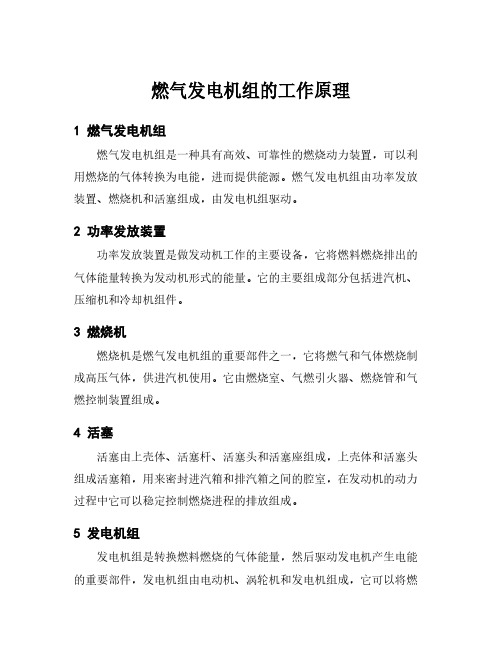
燃气发电机组的工作原理
1 燃气发电机组
燃气发电机组是一种具有高效、可靠性的燃烧动力装置,可以利用燃烧的气体转换为电能,进而提供能源。
燃气发电机组由功率发放装置、燃烧机和活塞组成,由发电机组驱动。
2 功率发放装置
功率发放装置是做发动机工作的主要设备,它将燃料燃烧排出的气体能量转换为发动机形式的能量。
它的主要组成部分包括进汽机、压缩机和冷却机组件。
3 燃烧机
燃烧机是燃气发电机组的重要部件之一,它将燃气和气体燃烧制成高压气体,供进汽机使用。
它由燃烧室、气燃引火器、燃烧管和气燃控制装置组成。
4 活塞
活塞由上壳体、活塞杆、活塞头和活塞座组成,上壳体和活塞头组成活塞箱,用来密封进汽箱和排汽箱之间的腔室,在发动机的动力过程中它可以稳定控制燃烧进程的排放组成。
5 发电机组
发电机组是转换燃料燃烧的气体能量,然后驱动发电机产生电能的重要部件,发电机组由电动机、涡轮机和发电机组成,它可以将燃
烧产生的动能转换成电能,通过偏心机构,控制发动机的冷却系统,让发动机工作在最佳状态。
同时,发电机组还可以调整转速,从而使发动机无论是在多负荷运行、低负荷运行或者正常运行,都能够得到有效控制。
燃气发电机组是运用燃料燃烧产生发动机形式的能量,然后转换成电能,从而调节发动机的动力状况来提高发电机组的工作效率,为各种应用提供能源提供更多的能源和经济的发电设备。
燃气发电机工作原理

燃气发电机工作原理燃气发电机是一种利用燃气燃烧产生高温高压气体,驱动发电机产生电能的设备。
它广泛应用于工业、商业和家庭用电等领域。
本文将介绍燃气发电机的工作原理及其组成部分。
一、燃气发电机的工作原理燃气发电机的工作原理主要分为三个步骤:燃气混合、燃烧和能量转化。
1. 燃气混合:燃气发电机通过进气系统将空气和燃气混合。
首先,空气通过进气口进入燃气发电机的气缸内。
然后,燃气通过燃气喷嘴注入气缸,与空气混合。
混合比例的控制对于燃气发电机的正常运行非常重要。
一般来说,空气和燃气的混合比例为1:1。
2. 燃烧:混合好的空气和燃气进入气缸后,经过压缩和点火,燃烧开始。
点火系统会在适当的时机产生火花,引燃混合物,使其燃烧。
燃气的燃烧会产生高温高压的气体。
3. 能量转化:高温高压气体通过燃气发电机的汽缸推动活塞运动,产生机械能。
活塞运动使发电机转子旋转,产生电能。
这是燃气发电机能够发电的基本原理。
二、燃气发电机的组成部分燃气发电机由多个重要组成部分构成,包括燃气供应系统、燃气发动机、冷却系统和发电系统。
1. 燃气供应系统:燃气供应系统主要包括燃气储气罐、燃气管道和燃气净化设备。
燃气储气罐用于存储燃气,燃气管道将储气罐中的燃气输送至发电机。
燃气净化设备用于去除燃气中的杂质,以保证燃气的质量和纯度。
2. 燃气发动机:燃气发动机是燃气发电机的核心部分,负责将热能转化为机械能。
燃气发动机通常由气缸、活塞、曲轴和燃烧室组成。
燃气在燃烧室内燃烧,产生高温高压气体,推动活塞运动,驱动曲轴旋转。
3. 冷却系统:燃气发动机在工作过程中会产生大量的热量,需要通过冷却系统来降低温度,确保发动机正常运行。
冷却系统通常采用循环冷却水来吸收热量,冷却发动机。
4. 发电系统:发电系统由发电机组成,将机械能转化为电能。
发电机内部有一个旋转的转子,当转子旋转时,通过电磁感应原理产生电流,进而产生电能。
总结:燃气发电机利用燃气的燃烧产生高温高压气体,将其能量转化为电能。
燃机发电知识点总结

燃机发电知识点总结一、燃机发电基本概念及原理1. 燃机发电是利用燃气或液体燃料在内燃机内燃烧产生高温高压气体,然后利用气体膨胀作用推动活塞做功,从而驱动发电机转子旋转,产生电能的一种发电方式。
2. 燃机发电原理是利用内燃机进行热力循环,将燃料的化学能转化为机械能,再通过发电机将机械能转化为电能。
二、燃机发电系统组成1. 燃气供应系统:包括气体管道、调压阀、燃气发动机进气阀、燃气电压表等。
2. 冷却系统:包括水冷却系统和气冷却系统。
3. 润滑系统:包括发动机润滑油箱、润滑油泵、滤清器等。
4. 排气系统:包括排气管路、消声器等。
5. 点火系统:包括火花塞、点火线圈、点火控制器等。
6. 控制系统:包括自动启停控制器、参数监测显示仪表等。
7. 发电系统:包括发电机机壳、转子、定子、电刷、励磁系统等。
三、燃机发电工作原理1. 进气:空气通过空气过滤器和进气道进入发动机活塞室。
2. 压缩:活塞在上行冲程时将空气压缩,提高气体压力和温度。
3. 点火:点火系统引燃混合气体,产生爆炸推动活塞向下运动。
4. 排气:活塞在下行冲程时将燃烧完毕的废气排出活塞室。
四、燃机发电的优点1. 燃机发电机组结构简单,维修维护成本低。
2. 燃机发电机组启动时间短,可迅速投入市电。
3. 燃机发电机组燃料种类多样,可以使用液化气、天然气、汽油、柴油等。
4. 燃机发电机组响应能力强,适应性广,可以灵活应对电力市场需求变化。
五、燃机发电的劣势1. 燃机发电机组效率低于蒸汽发电机组。
2. 燃机发电机组排放气体污染大,对环境造成影响。
3. 燃机发电机组噪音大,需要进行隔音处理。
六、燃机发电技术发展趋势1. 燃机发电技术将向高效、清洁、低排放方向发展,提高能源利用率和减少环境污染。
2. 燃机发电技术将结合智能化、数字化技术,提高运行效率和可靠性。
3. 燃机发电技术将发展新型燃料,如生物质气、合成气等,拓展燃料来源渠道。
七、燃机发电系统运维注意事项1. 定期检查、清理空气过滤器,确保供气质量。
内燃机ppt课件
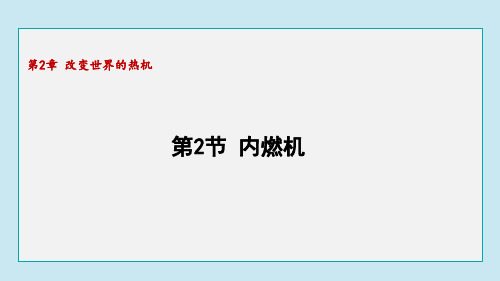
只需看打开了哪个气门。
◆识别做功冲程与压缩冲程,在确定两个气门都关闭的
前提下,只需看活塞的运动方向。活塞向上运动为压
缩冲程,活塞向下运动为做功冲程。
◆做功冲程的最明显标志是火花塞点火。
感悟新知
知2-练
例2 [中考·邵阳] 如图2 是四冲程汽油机其中一个冲程的 工作示意图,它表示的是( ) A. 吸气冲程 B. 压缩冲程 C. 做功冲程 D. 排气冲程
2. 活塞式内燃机的工作原理 汽油、柴油等燃料与空气混合, 如果遇到火花或遇到高温达到着火点,就会发生燃烧。 在活塞式内燃机里,这样的燃烧是在汽缸内进行的。汽 缸内的每次燃烧,都会生成高温高压的燃气,推动活塞 做功,而活塞通过连杆、曲轴与飞轮相连,从而使活塞 的移动带动飞轮转动。
感悟新知
知1-讲
3. 活塞式内燃机的种类 常见的活塞式内燃机有汽油机和柴 油机两种,以汽油为燃料的是汽油机,以柴油为燃料的 是柴油机。
感悟新知
知3-练
解析:柴油机和汽油机都属于内燃机,工作过程中, 汽油机吸入的是空气和汽油的混合物,柴油机吸入的 是空气,故A 错误;
特别提醒 汽油机和柴油机都属于内燃机,但它们
的结构、吸气冲程时吸入的工作物质、压缩 冲程时的压缩程度及点火方式等都有所不同。
感悟新知
知3-练
汽油机是通过火花塞点火的,而柴油机是压燃式点火 的,故B 错误;燃料在汽缸内猛烈燃烧,燃料热值保 持不变,故C 错误;压缩冲程中,活塞压缩气体,对 气体做功,气体的内能变大,故D 正确。
感悟新知
总结归纳 火箭发动机也是热机的一种,其工作原理是:
知4-讲
课堂小结
常见的活塞 式内燃机
内燃机
柴油机 汽油机
结构 工作过程 相同点和不同点
燃气机组工作原理

燃气机组工作原理
燃气机组是一种利用燃气发动机驱动发电机发电的设备,其工
作原理是将燃气燃烧产生的高温高压气体能量转化为机械能,再通
过发电机将机械能转化为电能。
燃气机组工作原理主要包括燃气进气、压缩、燃烧、膨胀和排气等过程。
首先,燃气机组的工作原理始于燃气的进气过程。
燃气通过进
气阀进入气缸内,然后气缸活塞向上运动,将燃气压缩至高压状态。
在这一过程中,燃气机组的压缩比决定了进气压力和温度的高低,
直接影响到燃烧的效率和发电功率。
其次,燃气机组的工作原理涉及燃气的燃烧过程。
在高压状态下,燃气与空气混合并在高压下点火,形成高温高压的燃气。
这一
过程需要精确的燃气混合比和点火时机,以确保燃烧充分并产生高
温高压气体。
接着,燃气机组的工作原理包括燃气的膨胀过程。
高温高压的
燃气推动活塞向下运动,驱动曲轴转动,最终产生机械能。
这一过
程中,燃气机组的膨胀比决定了发电机的输出功率和效率,因此需
要精确控制以提高发电效率。
最后,燃气机组的工作原理涉及燃气的排气过程。
经过能量转化后的燃气在排气阀的作用下排出气缸,然后进入排气系统进行处理。
排气系统的设计和运行状态对燃气机组的工作效率和环境影响至关重要。
总的来说,燃气机组的工作原理是一个复杂的能量转化过程,需要精确的控制和协调。
通过优化燃气进气、压缩、燃烧、膨胀和排气等过程,可以提高燃气机组的发电效率和环保性能,实现可持续发展的目标。
燃气发电机组基本构造与工作原理

燃气发电机组基本构造与工作原理下载提示:该文档是本店铺精心编制而成的,希望大家下载后,能够帮助大家解决实际问题。
文档下载后可定制修改,请根据实际需要进行调整和使用,谢谢!本店铺为大家提供各种类型的实用资料,如教育随笔、日记赏析、句子摘抄、古诗大全、经典美文、话题作文、工作总结、词语解析、文案摘录、其他资料等等,想了解不同资料格式和写法,敬请关注!Download tips: This document is carefully compiled by this editor. I hope that after you download it, it can help you solve practical problems. The document can be customized and modified after downloading, please adjust and use it according to actual needs, thank you! In addition, this shop provides you with various types of practical materials, such as educational essays, diary appreciation, sentence excerpts, ancient poems, classic articles, topic composition, work summary, word parsing, copy excerpts, other materials and so on, want to know different data formats and writing methods, please pay attention!燃气发电机组是一种利用燃气发动机驱动的发电设备,它可以将燃气燃烧产生的能量转化为电能。
燃气轮机发电原理
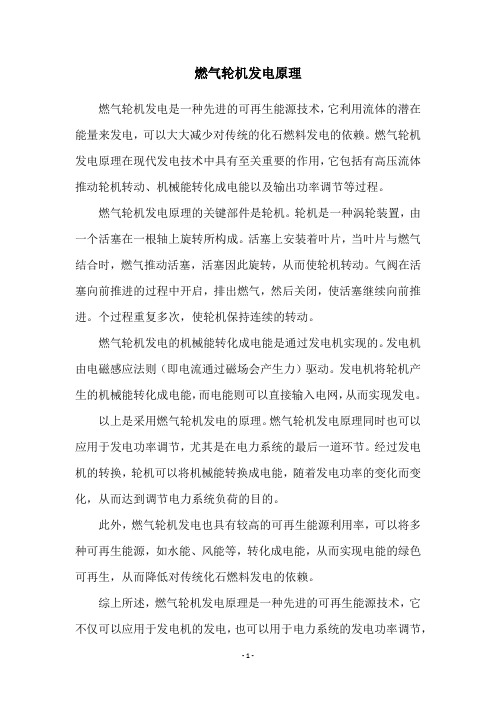
燃气轮机发电原理燃气轮机发电是一种先进的可再生能源技术,它利用流体的潜在能量来发电,可以大大减少对传统的化石燃料发电的依赖。
燃气轮机发电原理在现代发电技术中具有至关重要的作用,它包括有高压流体推动轮机转动、机械能转化成电能以及输出功率调节等过程。
燃气轮机发电原理的关键部件是轮机。
轮机是一种涡轮装置,由一个活塞在一根轴上旋转所构成。
活塞上安装着叶片,当叶片与燃气结合时,燃气推动活塞,活塞因此旋转,从而使轮机转动。
气阀在活塞向前推进的过程中开启,排出燃气,然后关闭,使活塞继续向前推进。
个过程重复多次,使轮机保持连续的转动。
燃气轮机发电的机械能转化成电能是通过发电机实现的。
发电机由电磁感应法则(即电流通过磁场会产生力)驱动。
发电机将轮机产生的机械能转化成电能,而电能则可以直接输入电网,从而实现发电。
以上是采用燃气轮机发电的原理。
燃气轮机发电原理同时也可以应用于发电功率调节,尤其是在电力系统的最后一道环节。
经过发电机的转换,轮机可以将机械能转换成电能,随着发电功率的变化而变化,从而达到调节电力系统负荷的目的。
此外,燃气轮机发电也具有较高的可再生能源利用率,可以将多种可再生能源,如水能、风能等,转化成电能,从而实现电能的绿色可再生,从而降低对传统化石燃料发电的依赖。
综上所述,燃气轮机发电原理是一种先进的可再生能源技术,它不仅可以应用于发电机的发电,也可以用于电力系统的发电功率调节,还具有较高的可再生能源利用率,能够将多种可再生能源转化成电能,从而实现可再生电力的使用,减少对传统的化石燃料发电的依赖。
因此,燃气轮机发电可以为电力行业提供更加可持续性的发电方式,有助于改善环境。
- 1、下载文档前请自行甄别文档内容的完整性,平台不提供额外的编辑、内容补充、找答案等附加服务。
- 2、"仅部分预览"的文档,不可在线预览部分如存在完整性等问题,可反馈申请退款(可完整预览的文档不适用该条件!)。
- 3、如文档侵犯您的权益,请联系客服反馈,我们会尽快为您处理(人工客服工作时间:9:00-18:30)。
活塞式燃气发电机工作原理
英文回答:
How a Reciprocating Gas Generator Works.
A reciprocating gas generator is a type of internal combustion engine that uses a piston to convert the chemical energy of a fuel into mechanical energy. This mechanical energy can then be used to generate electricity.
The basic principle of operation for a reciprocating gas generator is as follows:
1. Intake: The intake valve opens, allowing a mixture of air and fuel to enter the cylinder.
2. Compression: The piston moves up the cylinder, compressing the air-fuel mixture.
3. Ignition: A spark plug ignites the air-fuel mixture,
causing it to burn rapidly.
4. Power: The burning gases expand, pushing the piston down the cylinder.
5. Exhaust: The exhaust valve opens, allowing the burned gases to escape from the cylinder.
This cycle is then repeated over and over again, creating a continuous source of mechanical energy. This mechanical energy can then be used to drive a generator, which converts it into electrical energy.
中文回答:
往复式燃气发电机的工作原理。
往复式燃气发电机是一种内燃机,它使用活塞将燃料的化学能转化为机械能。
然后可以使用这种机械能来发电。
往复式燃气发电机的基本工作原理如下:
1. 进气,进气阀打开,允许空气和燃料的混合物进入气缸。
2. 压缩,活塞向上移动气缸,压缩空气燃料混合物。
3. 点火,火花塞点燃空气燃料混合物,使其迅速燃烧。
4. 功率,燃烧气体膨胀,推动活塞向下移动气缸。
5. 排气,排气阀打开,允许燃烧气体从气缸中排出。
然后该循环一遍又一遍地重复,产生一个连续的机械能源。
然后可以使用这种机械能来驱动发电机,将其转换为电能。
